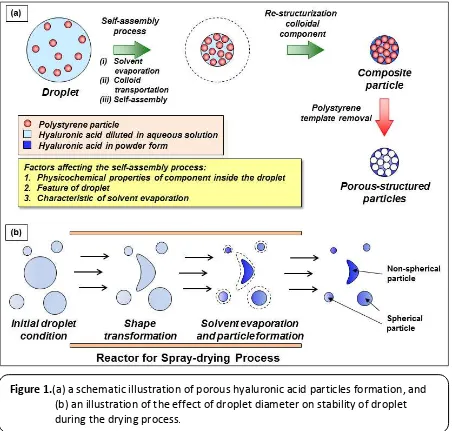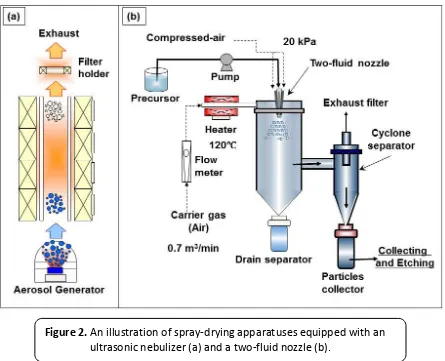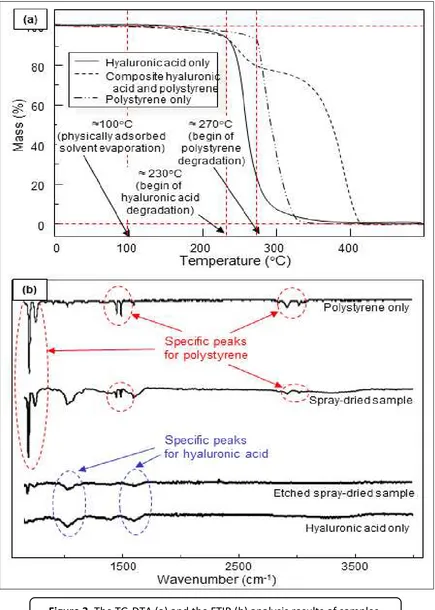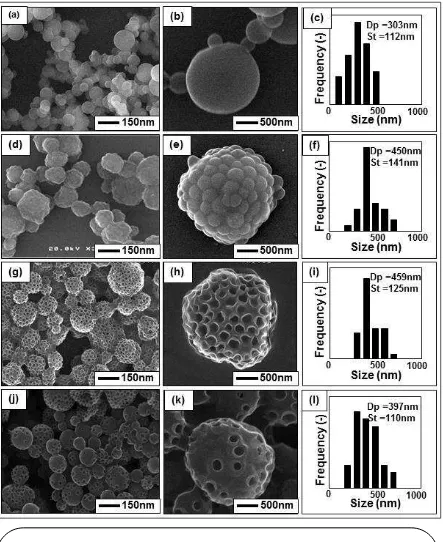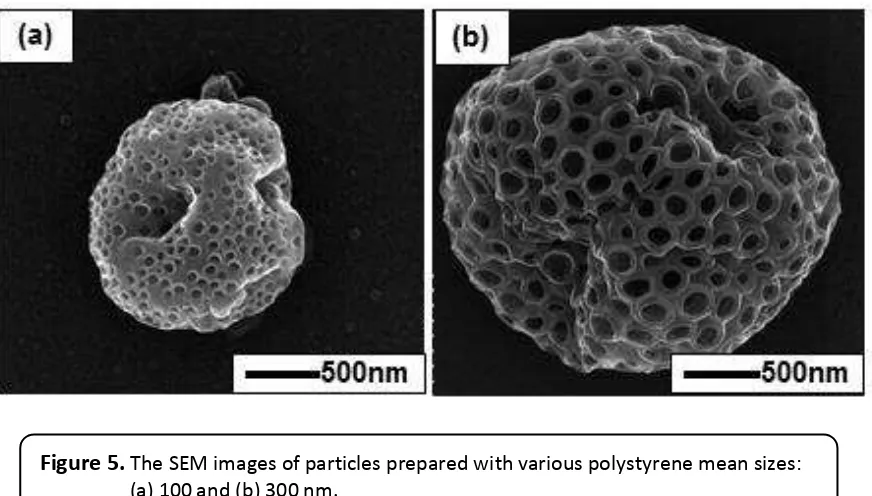Influences of Size and Amount of Colloidal Template and
Droplet Diameter on the Formation of Porous-structured
Hyaluronic Acid Particles
Asep Bayu Dani Nandiyanto 1,*, Kikuo Okuyama21Program Studi Kimia, Fakultas Pendidikan Matematika dan Ilmu Pengetahuan Alam, Universitas Pendidikan
Indonesia, Jl. Dr. Setiabudi no 229, Bandung 40154, Jawa Barat, Indonesia
2Department of Chemical Engineering, Hiroshima University, Kagamiyama 1-4-1, Higashi Hiroshima 739-8527,
Hiroshima, Japan
*Corresponding author: Email: [email protected]; Tel.: +62-22-2000-579
A B S T R A C T S A R T I C L E I N F O
Combination of spray drying and templating method has been reported as one of the best method to produce porous pharmaceutical particles. However, current development reports have shown successful formation of porous particles with improper information on what mechanism occurs during the synthesis process and what process parameters involve the creation of particles with controllable pore structures and morphologies. In this report, influences of spray-drying parameters (i.e., size and amount of colloidal template, and droplet diameter) on porous particle fabrication were investigated. Hyaluronic acid (as a model of pharmaceutical drug host component) and polystyrene spheres (as a model of template) were used. The experimental results showed that the spray-drying parameters strongly influenced the external morphology (i.e., spherical and doughnut-shaped), particle outer diameter (from 300 to 2000 nm), and porous configuration (i.e., number of hole cavities and pore sizes (from 100 to 300 nm)) of particles. To qualitatively explain our synthesis strategies to get porous structure, the proposal of the particle formation mechanism was added.
© 2016 Tim Pengembang Journal UPI
Article History :
Recived 10 Jun 2017 Reviced 20 Jun 2017 Accept 29 Aug 16
Avaiable online 01 Sep 2017 ____________________
Keyword :
Hyaluronic acid, Polymer template, Spray method, Porous, Doughnut.
Indonesian Journal of Science & Technology
DOI: http://dx.doi.org/10.17509/ijost.v2i2
1. INTRODUCTION
Until now, many methods have been developed to produce porous pharmaceutical particles (Faure et al., 2001;
Nandiyanto et al., 2014; Nandiyanto et al.,
2013; Nandiyanto & Ukuyama, 2011;
Nandiyanto et al., 2010). One of the best
method for fabricating porous-structured pharma-ceutical particles is combination of spray drying and templating method
(Nandiyanto et al., 2019). However, current
reported methods have shown successful formation of porous particles with improper information on what mechanism occurs during the synthesis process and what process parameters involve the creation of particles with controllable pore structures and morphologies. Further, disordered and uncontrollable pore structure and size distribution still remain as a main problem to get excellent performances.
In our previous reports, we studied the production of particles with controllable sizes and morphologies using a spray-drying method (Iskandar et al., 2009; Pavanetto,
2009; He et al., 2009). Effects of
physicochemical properties of raw materials (i.e., surface charge, size, and composition) and process parameters (i.e., droplet charge and diameter, temperature, and flow rate) on the formation of particles with a specific morphology was reported in detail and the results were compared with theoretical calculation. However, the successful formation of porous-structured particles was only for inorganic component, and we did not report on the effects and feasibilities for the bio and fragile materials where the use of heat in this process is limited due to possible reduction in activity and thermal decomposition of materials themselves. For the synthesis of spherical porous drug particles that are typically fragile, we combined the spray drying with chemical etching process. However, we demonstrated only the succesful production of porous particles with no information in detail about
process parameters involved during the process.
As a continuation of our work in producing porous pharmaceutical particles
(Nandiyanto et al., 2016), the purpose of this
study was to investigate influences of spray-drying parameters (i.e., size and amount of colloidal template, and droplet diameter) on the porous particle fabrication, in which to the best of our knowledge there is no report on the investigation of these parameters in the production of porous pharmaceutical particles. To control droplet diameter, we used two types of spray-driers: ultrasonic-assisted and two-fluid nozzle spray driers, which are effective to generate droplets with diameters of 4.50 and 10 m, respectively.
Hyaluronic acid (as a model of pharmaceutical drug host component) and polystyrene spheres (as a model of template) were used. Hyaluronic acid was selected because this material plays a critical role in cell growth, differentiation, migration, wound healing, and even cancer metastasis
(Vanbever, 1999). Therefore, understanding
how to design this material will be beneficial for advanced drug delivery applications. For the case of polystyrene spheres, we used this material as the template because this type of template can be easily prepared from inexpensive styrene monomer and the polystyrene spheres product is relatively spherical and monodispersed in size (He et al., 2009). Therefore, different from other reports (Faure et al., 2001; Nandiyanto, et al.,
2014; Nandiyanto, et al., 2013; Nandiyanto &
Okuyama, 2011; Nandiyanto, et al., 2010)
that had limitations in the homogeneity of pore size and shape, the use of polystyrene is effective to create particles with monodispersed pores.
DOI: http://dx.doi.org/10.17509/ijost.v2i2
and pore sizes (from 100 to 300 nm)) of particles. To qualitatively explain our synthesis strategies to get porous structure, the proposal of the particle formation mechanism was added.
2. HYPOTHETICAL ANALYSIS FOR THE CONTROL OF PARTICLE MORPHOLOGY IN THE SPRAY-DRYING METHOD
A schematic illustration mechanism of the formation of porous hyaluronic acid particles in the spray-drying method is shown in Figure 1a. In this approach, the particles were produced from an aqueous solution (containing hyaluronic acid and polystyrene spheres). The process is initiated by the atomization of solution to form droplets. The droplets are then introduced into the drying process. During the drying process, transfer of heat and component inside the droplet system happens, involving solvent evaporation, colloid transportation, and self-assembly component (Ogi et al., 2014). The self-assembly process continues along with the drying process, and re-structurization occurs until the most stable structure is gained, producing dried particles. To get porous structure, the dried particles are then put into the polystyrene removal process (i.e., etching process).
According to our hypothesis, during the drying process, the hyaluronic acid and polystyrene components self-assemble inside the droplet. They coalesce and form a composite hyaluronic acid/polystyrene particle. Then, after removal of the polystyrene via chemical etching process, the porous particle is produced. Based on this scenario, it is feasible that changing composition and type of polystyrene template would configure different porous structures, in which these will be in regulation of number of cavities/porosities and pore sizes.
Other parameter effectively controlling the final particle morphology is a feature of droplet (Figure 1b). Since droplet brings raw
material inside it, a larger droplet has a relation to the production of a larger particle. The correlation between the particle outer diameter (Dp) and the volume mean diameter of droplet (Dd) can be calculated, as follows (T. Ogi, A.B.D. Nandiyanto, K.
where Cd is the coefficient (in the ideal condition, Cd = 1). Mi, Ci, and i are the molecular weight, the concentration (mol/L), and the density (g/L) of component i added into the spray-drying solution, respectively. is the porosity in the particle. Based on
equation (1), the main influencing factor to control the final particle outer diameter is the droplet diameter used in the spray-drying process.
DOI: http://dx.doi.org/10.17509/ijost.v2i2
drying this type of droplet would result in the formation of non-spherical-shaped particle.
3. EXPERIMENTAL METHOD
3.1. Chemicals
Porous hyaluronic acid particles were produced by spray-drying of an aqueous precursor containing hyaluronic acid powder (Kewpie Corp., Japan) and polystyrene spheres (Japan Synthetic Rubber, Tokyo, Japan; mean sizes of 100 and 300 nm).
3.2. Preparation of porous-structured particles
In the preparation procedure, we used two steps of processes. The first step was the production of composite pharmaceutical component/template using the spray-drying method, and the second step was the chemical etching process.
DOI: http://dx.doi.org/10.17509/ijost.v2i2
3.2.1. Spray-drying method to generate
composite particles
Initially, hyaluronic acid powder was diluted into the aqueous solution by sonication in the ultrasonic bath. After all components were dissolved well, polystyrene colloidal spheres were added. The mixed solution was named the precursor. The mass ratio of polystyrene and hyaluronic acid was varied, i.e. 0; 1:10; and 1:1. The concentration of precursor was fixed at 0.10 wt%.
The precursor was then put into the spray drier. In this study, two types of spray-driers were used (shown in Figure 2). The first type of spray drier was equipped with an ultrasonic nebulizer atomizer (model NE-U12, Omron Corp., Tokyo, Japan operating at frequency 1.7 MHz). This atomizer was selected because it can produce droplets
with a mean size of 4.50 m. The second spray drier was equipped with a two-fluid nozzle atomizer (SD-1000, Eyela, Tokyo Rikakikai Co. Ltd., Tokyo, Japan), which can generate droplets with a mean size of 10 m. Each atomizer was equipped with a furnace (under a temperature of 120C) and a particle collector (either filter or cyclone). All processes were conducted under a flow of air. Detailed information about our spray drier are explained in our previous reports
(Nandiyanto et al., 2009; He, 2009).
3.2.2. Chemical etching process to get
porous structure in the particle
To remove polystyrene template, the spray-dried particles were put into the etching process using an organic solution (i.e., toluene (Sigma-aldrich, US)). The etched particles were then purified using a centrifugation process (15,000 rpm and 30
DOI: http://dx.doi.org/10.17509/ijost.v2i2
min; washed by ethanol) and dried at a temperature of 60C for one night to evaporate the remaining organic solution.
3.3. Characterization
The size and morphology of the prepared particles were examined using a scanning electron microscope (SEM, Hitachi S-5000; Hitachi, Japan; operated at 20 kV). To measure the size of the particles, we used a Ferret analysis method taken from the SEM images, in which the detailed information for the measurement using this method is reported in elsewhere (Maa, 1998). Chemical composition of the prepared particles was evaluated by a fourier transform infrared spectrometer (FTIR; Spectrum One System, Perkin-El er, U“A; i the ra ge − cm−1). A thermogravimetric and differential
thermal analyzer (TG-DTA; Exstar6000, Seiko Instruments Inc., Japan; heating rate =5C/min; carrier gas: air, 200 mL/min) was also used to analyze the thermal degradation of samples.
4. RESULTS AND DISCUSSION
4.1. Physicochemical properties analysis of
sample
Prior to further characterizations and production of hyaluronic acid particles, a TG-DTA analysis was conducted (Figure 3a). We analyzed three types of samples: hyaluro i
a id o ly , polystyre e o ly , a d
o posite hyaluro i a id a d polystyre e .
For all samples, the degradation of masses after about 100C was found and the zero mass was found after 400C. The major mass loss for hyaluronic acid only sample was found at about 230C, whereas that for polystyrene only sample was found at about 270C. When analyzing composite hyaluronic acid and polystyrene sample, two steps of mass degradations were found at 230 and 270C. From these results, three main temperatures are important: (i) the temperature of 100C shows the loss of mass due to physically adsorbed water from the
samples; (ii) the temperature of 230C describes the begins of hyaluronic acid decomposition; (iii) the temperature of 270C responses the begins of polystyrene decomposition. The masses of final residue for all samples are 0%, informing all samples are removed due to exothermic combustion. This verifies that the hyaluronic acid is fragile material and the use of heat for producing the hyaluronic acid particles must be considered (temperature of the process must be less than 200C). Further, these results give information that removing polystyrene from the composite hyaluronic acid/polystyrene particles using heat treatment is not effective because the decomposition temperature of hyaluronic acid is lower than that of polystyrene. Therefore, additional chemical etching process is required to remove polystyrene.
To confirm the effectiveness of combination of spray drying and chemical etching process, FTIR analysis was conducted (Figure 3b). We analyzed two samples: (i) spray-dried sample (prepared using the spray-drying process with the process temperature of 120C) and (ii) etched spray-dried sample. As standards for comparisons,
we a alyzed hyaluro i a id o ly a d polystyre e o ly sa ples. The FTIR spe tra
of composite sample detected the
polystyre e peaks (at a d − ,
− , a d − −1) and the
hyaluronic acid peaks (in the range of about 1000 and 1600 cm−1). No other adsorption
peaks appeared, indicating the hyaluronic acid and polystyrene self-assembled by neither chemical reaction nor intermediate component formation in the spray-drying process. After adding etching process to the spray-dried particles, the FTIR results exhibited absorption peaks only in the range of about 1000 and 1600 cm−1. The peaks of
DOI: http://dx.doi.org/10.17509/ijost.v2i2
the etching process, retaining just hyaluronic acid component in the final product.
DOI: http://dx.doi.org/10.17509/ijost.v2i2
4.1. Effect of mass ratio of polystyrene and
hyaluronic acid
Figure 4 shows the SEM images of particles prepared with various mass ratios of polystyrene and hyaluronic acid. Spray-dried precursor containing only hyaluronic acid resulted in the production of spherical particles with a smooth surface (Figures 4a-b). Spray-dried precursor containing hyaluronic acid and polystyrene spheres allowed the production of particles with moth-eye shapes (Figures 4c-d). Etching process to the moth-eye-shaped particles resulted in the appearance of porous structures in the final particle (Figures 4e-f), informing the effectiveness of etching process for removing polystyrene template from the formed composite particles. The external dimensions of the final porous particles before and after the etching processes remained unchanged.
Since the polystyrene dissolves into the etching agent, whereas the hyaluronic acid does not, we can conclude that the remaining skeleton structure must be from hyaluronic acid and the holes are from the removing polystyrene. This scenario is also strengthened by the FTIR result in Figure 3b
and the fact that the sizes of the holes created in the particle are identical to that of the initial polystyrene used. This result also shows that our template replication method is effective to create monodispersed hole size and structure.
To confirm that holes are from the replication of polystyrene spheres, spray drying of a precursor with less amount of polystyrene was conducted (Figures 4g-h). Number of hole cavities decreased with decreasing concentration of polystyrene in the initial precursor. This informs that the polystyrene governs the self-assembly process and occupies some spaces in the particle. Indeed, the concentration of polystyrene becomes higher, the space of
pores increases (after the polystyrene removed). These results demonstrate that a significant advantage of this method is that diameters are in the range of submicrometer. This result is in a good agreement with the above hypothetical analysis in equation (1). Assuming the density of hyaluronic acid is 4.00 g/mL (A.B.D. Nandiyanto, 2009), the use of the total concentration of precursor of 0.10 wt% and the droplet diameter of 4.50 m would result in the production of non-porous particles with sizes of about 280 nm. Indeed, adding the porosity into the calculation would result the final particle diameter of about 400 nm.
DOI: http://dx.doi.org/10.17509/ijost.v2i2
DOI: http://dx.doi.org/10.17509/ijost.v2i2
Although the etching process using toluene has been successfully removed polystyrene, remaining porous structures in the hyaluronic particle, the use of toluene for biomaterials intended for pharmaceutical applications is not recommended. Therefore, further findings for alternative etching agent are required and will be done in our future work.
4.2. Effect of polystyrene template size
Figure 5 shows the SEM images of particles prepared with various polystyrene sizes. Two types of polystyrene sizes were tested, i.e., 100 and 300 nm. Experimental results showed that the shape and size of holes were defined by that of the polystyrene template. Pores with size of about 100 nm were created when using 100 nm of polystyrene spheres (Figure 5a), and the larger pores were formed when using 300 nm of polystyrene spheres (Figure 5b). This result verifies that the polystyrene governs and plays an important role in the formation of pores in the particle.
4.3. Effect of droplet diameter
Figures 6a-d show the SEM images of particles prepared with various droplet diameters. Two types of droplet diameters were tested: 4.50 and 10 m. Experimental results showed that particle morphologies depended on the initial diameter of droplet. When using droplets with a mean diameter of 4.50 m, spherical porous particles with outer diameters of 459 nm were produced (Figures 6a-c). When changing the process using droplets with a mean diameter of 10 m, non-spherical particles with sizes of 1298 nm were obtained (Figures 6d-f). The change in particle outer diameter confirms the influence of the droplet diameter as discussed in above hypothesis regarding the effect of droplet diameter (equation (1)). Using equation (1), the increase in the droplet diameters from 4.50 to 10 m would result the increase of final particles outer diameter of more than twice.
In addition to final particle diameter, we found that the larger droplet used results in
DOI: http://dx.doi.org/10.17509/ijost.v2i2
the formation of non-spherical porous particles. The above result was in a good agreement with the above prediction analysis relating to the stability of droplet. As shown in equation (2), the Bond number is proportional to the square of the droplet diameter. Under the constant process condition, increases in the droplet diameter from 4.50 to 10 m result in the increase of the Bond number more than six times. The droplet will be deformed due to its inability to maintain a spherical shape.
High-magnified SEM images are shown in Figures 6b and e. We marked red and dashed line in Figures 6a and c to show that these figures are high-magnified images of
Figures 6a and d, respectively. Similar porous structures were obtained. The result clearly show that the droplet diameter impacts on from the self-assembly of component during drying process.
To confirm the effectiveness of the control of process parameters for preparing non-spherical (i.e. doughnut-shaped) particles with various porous configurations, we also varied the amount and size of polystyrene in the initial precursor (Figure 6g). We changed the polystyrene size into 300 nm and the ratio of polystyrene and hyaluronic acid into 1:10. As expected, by using a constant droplet diameter of 10 m, the changes in polystyrene size and amount affect only to the pore sizes and number of hole cavities, respectively.
The FTIR analysis result of the samples prepared with various droplet diameters is shown in Figure 6h. As a reference, initial hyaluronic acid powder was analyzed. The
results showed that the identical FTIR patterns were detected for all cases. This result confirms that the change in the droplet diameter in the spray-drying process followed by the etching process does not alter the changes in chemical structure of the hyaluronic acid. Therefore, the present method is effective to modify the particle outer morphology without changing the quality of the material properties.
5. CONCLUSION
Effects of process parameters (i.e., template size and amount, and droplet diameter) on the fabrication of morphology-controllable pharmaceutical particles have been investigated. Experimental results showed that controlling the parameters is effective to produce particles with controllable number of hole cavities, pore sizes, outer diameter, and outer shapes. Since the hyaluronic acid is used broadly for various drug applications, understanding how to control the morphology and porous structure of hyaluronic acid particles is prospective for advanced drug delivery applications, such as administration of drugs parenterally and by aerosol inhalation.
6. ACKNOWLEDGEMENTS
The authors thank to Ms. Yui Kawano for her help in assisting this research. This research was supported by RISTEK DIKTI (Grant: Penelitian Terapan Unggulan Perguruan Tinggi (PTUPT)).
7. AUTHOR’S NOTES
DOI: http://dx.doi.org/10.17509/ijost.v2i2
DOI: http://dx.doi.org/10.17509/ijost.v2i2
8. REFERENCES
Faure, A., York, P., & Rowe, R. C. (2001). Process control and scale-up of pharmaceutical wet granulation processes: a review. European Journal of Pharmaceutics and Biopharmaceutics, 52(3), 269-277.
He, M., Zhao, Z., Yin, L., Tang, C., & Yin, C. (2009). Hyaluronic acid coated poly (butyl cyanoacrylate) nanoparticles as anticancer drug carriers. International Journal of Pharmaceutics, 373(1), 165-173.
Iskandar, F., Nandiyanto, A. B. D., Widiyastuti, W., Young, L. S., Okuyama, K., & Gradon, L. (2009). Production of morphology-controllable porous hyaluronic acid particles using a spray-drying method. Acta Biomaterialia, 5(4), 1027-1034.
Maa, Y. F., Nguyen, P. A., Andya, J. D., Dasovich, N., Sweeney, T. D., Shire, S. J., & Hsu, C. C. (1998). Effect of spray drying and subsequent processing conditions on residual moisture content and physical/biochemical stability of protein inhalation powders. Pharmaceutical research, 15(5), 768-775.
Mumenthaler, M., Hsu, C. C., & Pearlman, R. (1994). Feasibility study on spray-drying protein pharmaceuticals: Recombinant human growth hormone and tissue-type plasminogen activator. Pharmaceutical Research, 11(1), 12-20.
Nandiyanto, A. B. D., Kim, S. G., Iskandar, F., & Okuyama, K. (2009). Synthesis of spherical mesoporous silica nanoparticles with nanometer-size controllable pores and outer diameters. Microporous and Mesoporous Materials, 120(3), 447-453.
Nandiyanto, A. B. D., Hagura, N., Iskandar, F., & Okuyama, K. (2010). Design of a highly ordered and uniform porous structure with multisized pores in film and particle forms using a template-driven self-assembly technique. Acta Materialia, 58(1), 282-289.
Nandiyanto, A. B. D., & Okuyama, K. (2011). Progress in developing spray-drying methods for the production of controlled morphology particles: From the nanometer to submicrometer size ranges. Advanced Powder Technology, 22(1), 1-19.
Nandiyanto, A. B. D., Suhendi, A., Arutanti, O., Ogi, T., & Okuyama, K. (2013). Influences of surface charge, size, and concentration of colloidal nanoparticles on fabrication of self-organized porous silica in film and particle forms. Langmuir, 29(21), 6262-6270.
Nandiyanto, A. B. D., Suhendi, A., Ogi, T., Umemoto, R., & Okuyama, K. (2014). Size-and charge-controllable polystyrene spheres for templates in the preparation of porous silica particles with tunable internal hole configurations. Chemical Engineering Journal, 256, 421-430.
DOI: http://dx.doi.org/10.17509/ijost.v2i2
Ogi, T., Nandiyanto, A. B. D., & Okuyama, K. (2014). Nanostructuring strategies in functional fine-particle synthesis towards resource and energy saving applications. Advanced Powder Technology, 25(1), 3-17.
Pavanetto, F., Conti, B., Genta, I., & Giunchedi, P. (1992). Solvent evaporation, solvent extraction and spray drying for polylactide microsphere preparation. International Journal of Pharmaceutics, 84(2), 151-159.
